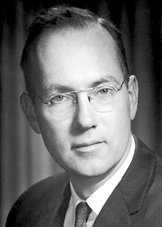 50 Years ago, Charles Townes headed the team that invented the Laser at Bell Labs … he was 45 years old and having a blast cooking up all this really cool stuff … so where is he now 50 years later? … would you believe he is still doing the same at the age of 95. The concept of retiring is quite alien to him, and he would far rather spend his time doing what he is truly passionate about … cutting edge science.
50 Years ago, Charles Townes headed the team that invented the Laser at Bell Labs … he was 45 years old and having a blast cooking up all this really cool stuff … so where is he now 50 years later? … would you believe he is still doing the same at the age of 95. The concept of retiring is quite alien to him, and he would far rather spend his time doing what he is truly passionate about … cutting edge science.
When asked about the laser, he comments, “I’m still very pleased at how useful the laser is, but, of course, they’re so common now, that I don’t marvel every time I see one,” he chuckles.
So how on earth did he come up with an idea like the laser all those years ago. At the time he had already invented the predecessor to the laser — the invisible beam MASER, that used microwaves instead of light. When asked, he explained how the laser idea suddenly struck him …
“I worked on it and worked on it, and nothing worked. I woke up early in the morning, went out in the park, sat on a park bench worrying about it, thinking, ‘Why haven’t we been able to get any ideas?’ I said, well we tried this, tried that, and… Ooh, wait a minute! Atoms and molecules can do this… Oh, I think I see a way of using them to do it — to have them do it for us. So, I had this sudden realization that we could do it. It was a great moment for me. I quickly pulled out a pen and wrote down some notes and equations. ‘Yeah,’ I thought. ‘It looks like it will probably work.'”
 That bench is still there … well sort of, the moment was captured in Bronze (hey I thought you had to be dead before you got a statue!!) … and of course he was (rightfully) recognized with the award of a Nobel prize for Physics in 1964 as well.
That bench is still there … well sort of, the moment was captured in Bronze (hey I thought you had to be dead before you got a statue!!) … and of course he was (rightfully) recognized with the award of a Nobel prize for Physics in 1964 as well.
Today he is still publishing scientific discoveries, working every day at UC Berkeley with a young team of astrophysicists. The team takes starlight from its three telescopes and merges it with a laser beam. And in the pattern of interference between the lights, they can see stars and other objects at a resolution comparable to that of a space telescope — without having to go into space.
“We take the light from a star,” Townes explains, “coming to these two telescopes and join it. Then, the farther apart we put the telescopes, the more resolution we can get on the star, and see more and more detail.”
When asked about retiring, he explains that he has never actually worked, instead he simply has fun doing what he likes best, physics.
“Well, science is so much fun, why stop? I think people should choose the things they find most interesting and enjoy doing. The things that you enjoy doing are the things you are likely to do best. I like physics, I just have good fun. People pay me for it, of all things.”
If you would like to find out more about his amazing life … born in 1915 … worked on radar systems for B52 bombers during the second world war .. masers, lasers of course, and lots more … then click here. and also here.
Also, here is an interview with him …